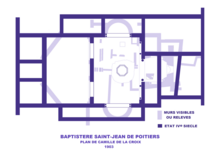St-Jean de Poitiers (Baptistery)
The St-Jean Baptistery in Poitiers is the oldest Christian building in France. Parts of it date from the middle of the 4th century (civil construction of Roman architecture ). A baptismal font was built into the Roman house as early as the 5th century and the building was probably given its present form in the 6th century, in Merovingian times, as a baptistery . The name means baptistery of St. John .
Exterior view
From the east side, the typical rigid decorative forms of early Christianity can be clearly seen in the gable field: small pilasters with arches and triangular gables. These are originally classic designs of the Roman Empire , but here they have no function and have become purely decorative elements. This building can be compared with the gate hall of Lorsch in Hesse from around 800, which has very similar forms of decoration.
Design of the interior
In the interior of the baptistery, the main apse connects to the east , which was probably added at the beginning of the 6th century and thus represents the oldest Christian interior on French soil. This east apse is a hexagonal central space that is encased in a rectangular manner on the outside - i.e. H. the hexagon does not come into its own on the outside.
The main room of the baptistery was decorated with frescoes in the 12th and 13th centuries . The history of the building is not entirely clear. In the 6th or 7th century the chapel was enlarged (and / or raised) and the east apse was added. In any case, a rectangular room with apses on three sides and a western porch that was added later was created. Only the east apse is still original, the other two apses were later changed.
In the middle of the main room is the oldest baptismal font in France. Its design indicates that baptisms of adults were common at the time of construction and that the person to be baptized went down into the water as if into a river, similar to how Christ was baptized by John in the Jordan.
The paintings on the east wall date from around or shortly after 1100. The simple, rigid structure as on the outer wall has also been used inside - with small columns and triangular shapes above. In the middle above the east apse, where the altar stood, Christ is enthroned in a slightly oval halo. He is accompanied by two hovering angels making music and standing saints or apostles.
Some light areas have been touched up, creating a somewhat impressionistic impression that certainly does not match the original appearance. The detailed shots show that the light lines have also been added later and thus appear a bit exaggerated in their effect.
On the lower part of the east wall there are several layers of frescoes on top of each other. In the Gothic period, the Romanesque paintings were no longer considered appropriate, but instead of removing them, they simply applied a new layer of mortar and provided them with new frescoes. This later layer can be removed using special processes and the old Romanesque paintings can be seen again. In Poitiers, this process was partially used, so that parts of both layers now abut one another. The right part of this area is Romanesque and shows a rider named Constantine. It is probably about the Roman emperor Constantine . The left part of the scene is Gothic and dates from the 13th century.
Demolition plans in the 19th century
Despite the building's uniqueness for France, it was temporarily threatened with demolition in the 19th century when a road was to be built here. It was ultimately traced around the building.
literature
- Jean Lassus: Early Christian and Byzantine World . 1968, p. 115
- Hermann Fillitz : The Middle Ages I . (= Propylaen art history, vol. 5. Frankfurt am Main - Berlin [1969] 1990), fig. 136
- Thorsten Droste : The Poitou . Cologne 1990. (DuMont Art Travel Guide) 4th edition 1990, pp. 97–99
- Marcel Durliat : Romanesque Art . Freiburg-Basel-Vienna 1983. Fig. 395
- André Corboz, Henri Stierlin (Ed.): Early Middle Ages (= Architecture of the World, Vol. 14), pp. 16-19
Web links
Individual evidence
- ^ André Corboz, Henri Stierlin (ed.): Early Middle Ages (Architektur der Welt, Vol. 14), p. 13
Coordinates: 46 ° 34 ′ 46 ″ N , 0 ° 20 ′ 55 ″ E




